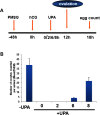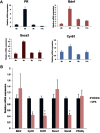Ulipristal blocks ovulation by inhibiting progesterone receptor-dependent pathways intrinsic to the ovary
- PMID: 23012316
- PMCID: PMC3676258
- DOI: 10.1177/1933719112459239
Ulipristal blocks ovulation by inhibiting progesterone receptor-dependent pathways intrinsic to the ovary
Abstract
Ulipristal acetate (UPA), a progesterone receptor (PR) modulator, is used as an emergency contraceptive in women. Here, using a mouse model, we investigated the mechanism of action of UPA as an ovulation blocker. In mice, ovulation is induced ~12 hours following the treatment with exogenous gonadotropins, including human chorionic gonadotropin (hCG), which mimics the action of luteinizing hormone (LH). When administered within 6 hours of hCG treatment, UPA is a potent blocker of ovulation. However, UPA's effectiveness declined significantly when it was given at 8 hours post hCG. Our study revealed that, when administered within 6 hours of hCG, UPA blocks ovulation by inhibiting PR-dependent pathways intrinsic to the ovary. At 8 hours post hCG, when the PR signaling has already occurred, UPA is unable to block ovulation efficiently. Collectively, these results indicated that UPA, when administered within a critical time window following the LH surge, blocks PR-dependent pathways in the ovary to function as an effective antiovulatory contraceptive.
Conflict of interest statement
Figures




Similar articles
-
The effects on ovarian activity of ulipristal acetate when 'quickstarting' a combined oral contraceptive pill: a prospective, randomized, double-blind parallel-arm, placebo-controlled study.Hum Reprod. 2015 Jul;30(7):1566-72. doi: 10.1093/humrep/dev115. Epub 2015 May 20. Hum Reprod. 2015. PMID: 25994664 Clinical Trial.
-
Combined oral contraceptive interference with the ability of ulipristal acetate to delay ovulation: A prospective cohort study.Contraception. 2018 Dec;98(6):463-466. doi: 10.1016/j.contraception.2018.08.003. Epub 2018 Aug 14. Contraception. 2018. PMID: 30118684 Free PMC article.
-
A randomized study on pharmacodynamic effects of vaginal rings delivering the progesterone receptor modulator ulipristal acetate: research for a novel estrogen-free, method of contraception.Contraception. 2014 Dec;90(6):565-74. doi: 10.1016/j.contraception.2014.08.006. Epub 2014 Aug 12. Contraception. 2014. PMID: 25193534 Free PMC article. Clinical Trial.
-
Ulipristal acetate: critical review about endometrial and ovulatory effects in emergency contraception.Reprod Sci. 2014 Jun;21(6):678-85. doi: 10.1177/1933719113519178. Epub 2014 Jan 18. Reprod Sci. 2014. PMID: 24440997 Review.
-
Mechanisms involved in the contraceptive effects of ulipristal acetate.Reproduction. 2020 Mar;159(3):R139-R149. doi: 10.1530/REP-19-0355. Reproduction. 2020. PMID: 31689233 Review.
Cited by
-
Progesterone Receptor Serves the Ovary as a Trigger of Ovulation and a Terminator of Inflammation.Cell Rep. 2020 Apr 14;31(2):107496. doi: 10.1016/j.celrep.2020.03.060. Cell Rep. 2020. PMID: 32294429 Free PMC article.
-
Mechanism of Action of Ulipristal Acetate for Emergency Contraception: A Systematic Review.Front Pharmacol. 2016 Jan 12;6:315. doi: 10.3389/fphar.2015.00315. eCollection 2015. Front Pharmacol. 2016. PMID: 26793107 Free PMC article. Review.
-
Brain reactivity during aggressive response in women with premenstrual dysphoric disorder treated with a selective progesterone receptor modulator.Neuropsychopharmacology. 2021 Jul;46(8):1460-1467. doi: 10.1038/s41386-021-01010-9. Epub 2021 Apr 29. Neuropsychopharmacology. 2021. PMID: 33927343 Free PMC article. Clinical Trial.
-
Controlled ovulation of the dominant follicle using progestin in minimal stimulation in poor responders.Reprod Biol Endocrinol. 2017 Sep 5;15(1):71. doi: 10.1186/s12958-017-0291-0. Reprod Biol Endocrinol. 2017. PMID: 28870217 Free PMC article. Clinical Trial.
-
Progesterone-mediated angiogenic activity of endothelial progenitor cell and angiogenesis in traumatic brain injury rats were antagonized by progesterone receptor antagonist.Cell Prolif. 2017 Oct;50(5):e12362. doi: 10.1111/cpr.12362. Epub 2017 Jul 28. Cell Prolif. 2017. PMID: 28752929 Free PMC article.
References
-
- Trussell J, RodrIguez G, Ellertson C. New estimates of the effectiveness of the Yuzpe regimen of emergency contraception. Contraception. 1998;57(6):363–369. - PubMed
-
- Wilcox AJ, Day Baird D, Dunson DB, McConnaughey DR, Kesner JS, Weinberg CR. On the frequency of intercourse around ovulation: evidence for biological influences. Hum Reprod. 2004;19(7):1539–1543. - PubMed
-
- Wilcox AJ, Weinberg CR, Baird DD. Timing of sexual intercourse in relation to ovulation — effects on the probability of conception, survival of the pregnancy, and sex of the baby. N Engl J Med. 1995;333(23):1517–1521. - PubMed
-
- Guillebaud J. Time for emergency contraception with levonorgestrel alone. Lancet. 1998;352(9126):416–417. - PubMed
Publication types
MeSH terms
Substances
Grants and funding
LinkOut - more resources
Full Text Sources
Molecular Biology Databases
Research Materials
Miscellaneous

